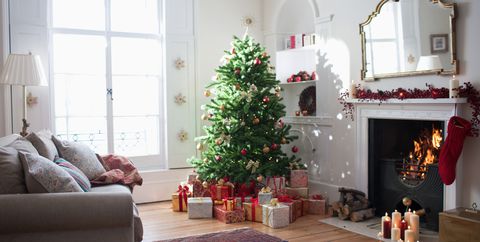Here in Britain, we certainly love a Christmas tree in our homes. Most of us jump at the opportunity to make over our homes and love how those twinkling lights make us feel on a bleak winters day.
 But, this has not always been something we have done to mark the Christmas period. So where did the Christmas tree start? Many people just take it as a given to have a Christmas tree, but if you really think about it, it does seem odd to bring a tree into our houses. We wouldn’t do this with any other kind of big tree, so why a pine tree.
But, this has not always been something we have done to mark the Christmas period. So where did the Christmas tree start? Many people just take it as a given to have a Christmas tree, but if you really think about it, it does seem odd to bring a tree into our houses. We wouldn’t do this with any other kind of big tree, so why a pine tree.
For all those who love to decorate their homes for Christmas and for those who are curious, we have put together a brief history of the Christmas Tree here on Premier Lofts so that you can know the true meaning of it when you put yours up this Christmas, should you celebrate it.
How it All Started
Way before the advent of Christianity, trees and plants alike which remained green all year round has a special meaning for people in the winter months.In fact, it was believed in many countries across the world that evergreens would keep evil spirits at bay. Nowadays, people simply use evergreens to spruce up their festive décor.
In the northern hemisphere, the shortest day and the longest night of the year falls on the 21st of the December and the 22nd of December. This is known as the winter solstice, In ancient times, people believed that the sun was actually a God and that winter only came because God (the sun) could sick and weak. They celebrated the solstice because it was a sign that the sun God would return to full health. Evergreens, such a pine trees, were an indicator that the sun God was strong and summer would return once more.
The early Romans marked the solstice with a feast to honour Saturn, the god of agriculture. The Romans marked the occasion, they often decorated their homes and temples with evergreens as they were a symbol of a fruitful harvest and everlasting life.
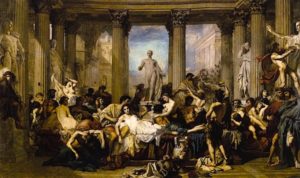 Of course, these were not Christmas Trees as such, seeing as they were not used to mark the Christian festival nor were they used the same way we use them now.
Of course, these were not Christmas Trees as such, seeing as they were not used to mark the Christian festival nor were they used the same way we use them now.
Germany started the Christmas Tree
Germany is credited with popularising the concept of the Christmas Tree as we know it. It was in the 16th century when devout Christians living in what is now Germany brought decorated trees into their homes.
It is of popular, historical belief that the leader of the Protestant Reformation across Europe, Martin Luther, first added lighted candles to the tree. It has been documented that it was a result of him being in awe of the brilliant stars which were twinkling amidst evergreens. He wanted to recreate this.
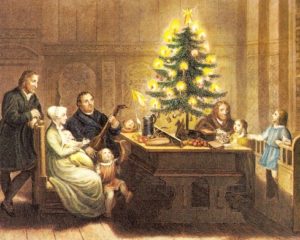 Martin Luther’s British contemporary, Oliver Cromwell, warned the English public about the “heathen traditions” of Christmas carols, decorated trees and basically anything that is fun about Christmas as it disgraced the “sacred event”.
Martin Luther’s British contemporary, Oliver Cromwell, warned the English public about the “heathen traditions” of Christmas carols, decorated trees and basically anything that is fun about Christmas as it disgraced the “sacred event”.
Victorian England Popularised the Christmas Tree in Britain
In 1846, Queen Victoria and her German husband, Prince Albert, were sketched in the Illustrated London News standing next to a Christmas Tree alongside their children. Victoria was a very popular monarch and it was the norm that anything she did immediately became fashionable. Meaning, that the Christmas Tree was now considered a British tradition from this point on.
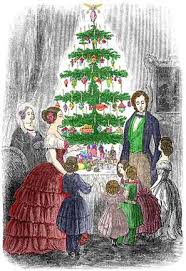 There was already a tradition of decorating churches and homes with evergreens at Christmas time, but the custom of decorating an entire tree was unknown in Britain until it was popularised with the Victorian monarchy, for the middle-class at least.
There was already a tradition of decorating churches and homes with evergreens at Christmas time, but the custom of decorating an entire tree was unknown in Britain until it was popularised with the Victorian monarchy, for the middle-class at least.
Interestingly, the Anti-German sentiment after World War I briefly reduced the Christmas Tree’s popularity in Britain. By the 1920s, the use of a Christmas Tree had spread to all classes.
The Rise of Artificial Trees
The first artificial Christmas tree was developed in Germany during the 19th century. These artificial trees were first made using goose feathers that were dyed green. This was a response to continued deforestation in Germany.
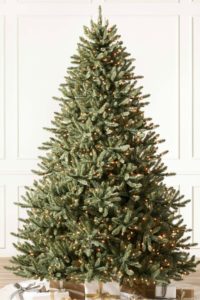 The US-based Addis Brush Company created the first artificial Christmas tree with brush bristles in 1930.
The US-based Addis Brush Company created the first artificial Christmas tree with brush bristles in 1930.
Most modern artificial trees are now made from plastic recycled from packaging materials.

